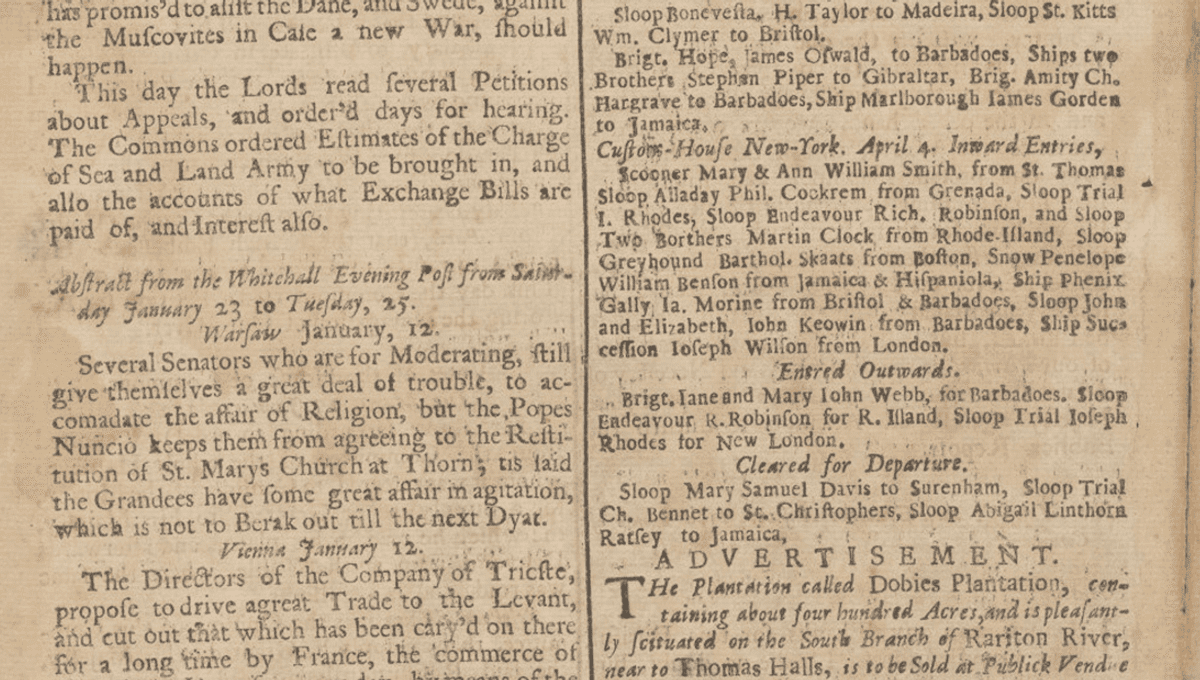
An analysis of old newspapers in the USA has highlighted the persistence of the enslavement and indentured servitude of Native Americans into the 19th century.
Two researchers from the Annenberg School for Communication and Brown University searched through newspapers from 1704-1804, souring for references to Indigenous Americans (largely termed “Indians” by the papers) being sold, or asking for readers to “return” self-emancipated Indigenous Americans to their captors. The authors found that there were over 75,000 references to the word “Indian” during this timeframe in the papers available, with 1,066 references appearing in adverts relating to sales of slaves or notices offering rewards for their return.
“Ran away from Capt. John Aldin of Boston, on Monday the 12th Currant, a tall lusty Indian Man call’d Harry, about 19 Years of Age, with a black Hat, brown Ozenbridge Breeches and Jacket,” one advert run in the 19 June 1704 edition of The Boston News-Letter read. “Whoever will take up said Indian, and bring or convey him safe either to John Campbell Post master of Boston, or to Mr. Nathaniel Niles of Kingstown in Naraganset, Master to said Indian, shall have a sufficient Reward.”
The ages of the enslaved and self-emancipated Native Americans mentioned by the newspapers ranged from six months – a baby sold alongside their mother – to 45 years old, with the majority falling between 16 and 20 years old.
“Over the time period included in this study, there was an uptick in the average age for the first few decades, and then a trend downwards. The fact that the averages of the enslaved and unfree population in these advertisements decrease over time, rather than increase, suggests that this is not simply a case of a stable enslaved and unfree population aging through the century,” the team noted in their paper. “Instead, it suggests an active replenishment of the wider enslaved and unfree Indigenous population, both through ongoing importation from the Caribbean and other parts of North America as well as multi-generational enslavement through reproduction (something we know enslavers specifically valued and cultivated).”
The practice of selling Native Americans as slaves continued into the 1860s, past the time surveyed by the team. The team notes that the language around how slaves and indentured servants were sold changed over the 100 years they studied. Generally, the advertisements did not specify whether the person being sold was a slave or an indentured servant. The way readers distinguished between the two was down to whether or not the advert listed how many years of “time remaining to serve” were left. If no time was listed, this would “surely lead the buyer to understand that this was a slave for life”.
“What is somewhat surprising is that the specific verbiage of slavery increases, not decreases, over time in these advertisements,” the team writes, adding that it noticeably picked up after 1760. “This is likely due to the proliferation of other kinds of unfreedom, including an expansion of indentured servitude, prompting the need to be more specific when servitude is referring to outright enslavement.”
The team writes that the media of the time had a “vital and often underexamined role” in sustaining slavery, and profiting from it.
“Newspaper printers gave enslavers an incredibly powerful and public bullhorn through which to assert their attempted ownership and mastery over Indigenous people, to vastly reduce Indigenous identities through erasing tribal affiliations and names,” they write, “and to control the narratives about the skills, physiognomic features, and supposed moral liabilities people listed as runaway or for sale possessed (or lacked).”
“In a way, printers themselves acted as slave brokers by facilitating the buying and selling of people,” co-author Anjali DasSarma said in a statement. The team draw particular attention to how publishing ads asking people to return self-freed individuals turned “citizens into ‘slave catchers’” while the media profited.
“Our analysis of these advertisements reveal an overlooked and important aspect of the history of this country,” co-author Linford Fisher added. “America was not only built on Native American land, it was also built on the backs of Native American laborers, who were enslaved by the tens of thousands and who worked alongside enslaved Africans on plantations and in households well into the nineteenth century.”
The study was published in the journal Slavery and Abolition.
Source Link: Old Newspaper Ads Reveal How Native American Slavery Continued Into The 19th Century